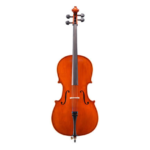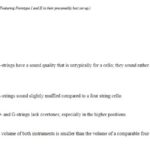MEETING WITH UEDA [3] (May 13th, 2015)
The ordered fine-tune pegs (made by German manufacturer Wittner) were installed. They contain a sophisticated gear mechanism that allows an easy and precise tuning of each string without having to use adjusters on the tailpiece.
The fine-adjusters were removed from the tailpiece. A little bridge was added on it in order to avoid direct contact of the strings to the tailpiece body. The size of the eyelets for taking the lower ends of the strings were measured differently for each string; making the high E-string the shortest and the low C-string the longest. This was done in an attempt to take tension from the high strings and achieve a less nasal sound of the E-string.
Because of the removal of the tailpiece adjusters the distance of the string-length between bridge and tailpiece (and thus also the overall length of the strings) increased considerably, it was considered to change the position of the tailpiece by lengthening the cord it is attached by to the endpin socket. This will be done after the next testing period.
TEST RESULTS [3] (Featuring fine-tuning pegs and a lighter tailpiece.)
The Wittner fine-tune pegs are working perfectly and seem to make the use of adjusters on the tailpiece superfluous. (Final judgment will require some more time of observation.21)
The lever mechanism inside the pegs provides a gear transmission of 8.5:1. This makes precise fine-tuning very easy. The number of necessary rotations of a peg to put a new string increases compared to traditional pegs, but not to an unreasonable extent.
Since the strings will be stretched at a quite slow pace to their final pitch the danger of breaking them becomes much smaller. This is especially important in case of the very thin E-string.
The new tailpiece presents a significant optical and practical but only a slight acoustic improvement. The overall sound quality has changed positively but the E-string’s sound quality hasn’t changed very much.
The installation of the fine-tune pegs has allowed for some important insights of optimizing the outfit of any cello, not only the Prototype I. If they continue to function as at the present time they could be well considered as a permanent replacement for tailpiece adjusters. Certainly they have recommended themselves for the next Prototype and the project’s final instrument because of the diminished risk of breaking the E-string when tuning. Acoustic advantage may be small but installment is financially justifiable while practicality is high.
Picture 1:The tailpiece in its present shape. Its head was designed to accommodate the adjusters and is therefore a little bit too wide. This will be considered to be corrected after having tested Prototype II which will be equipped with fine-tuning pegs and a narrower tailpiece from the start.
21 Two months after installation: Pitch sinks slightly after a couple of days. Whether this is due to the weather or the pegs moving is not clear yet. Five months after installation: The sinking of the pitch has nothing to do with the pegs. They work perfectly and make the use of adjusters superfluous.






